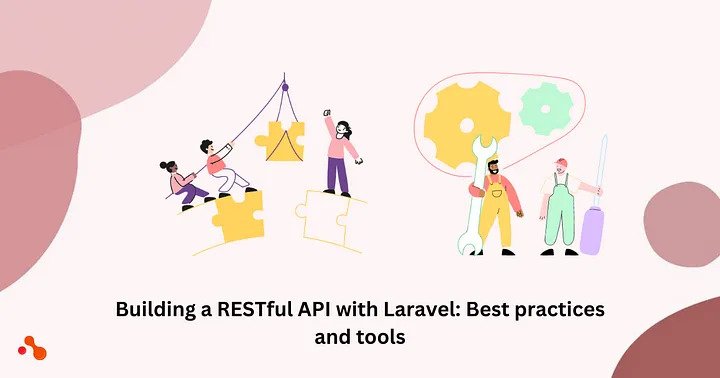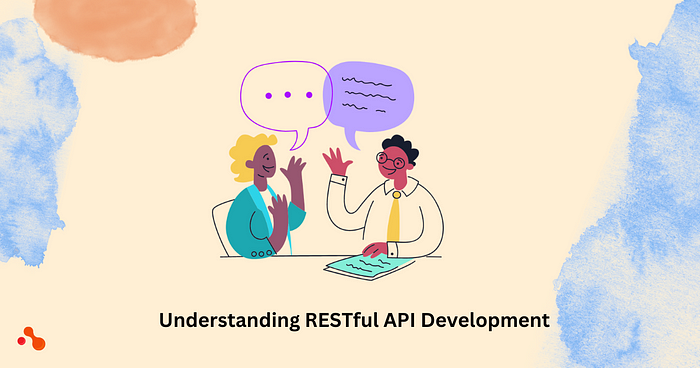Building a RESTful API with Laravel: Best practices and tools
Md. Asif Iqbal . Follow
1 year ago
Introduction
Are you looking to hire remote developers for your team? In today’s globalized world, diversity and inclusion are crucial for the success of any organization. This blog aims to provide effective strategies for building a diverse and inclusive remote development team. You can foster creativity, innovation, and better problem-solving by embracing differences in backgrounds, experiences, and perspectives. So, let’s explore how you can attract and retain a diverse talent pool and create a welcoming environment for everyone, regardless of location or background.

Understanding RESTful API Development

- RESTful architecture is an approach to designing web services that are scalable, stateless, and based on a set of principles. It stands for Representational State Transfer.
- RESTful APIs (Application Programming Interfaces) are a type of web service that follows the principles of REST architecture.
- The principles of RESTful architecture include:
- Stateless: Each request from a client to a server should contain all the necessary information for the server to understand and process it. The server doesn’t need to maintain any session information.
- Uniform Interface: The API should have a consistent and standardized way of interacting with resources through HTTP methods (GET, POST, PUT, DELETE) and resource identifiers (URLs).
- Client-Server Separation: The client (user interface) and the server (data storage) are separate entities communicating through HTTP requests and responses.
- Cacheability: The client can cache Responses from the server to improve performance.
- Layered System: The architecture can be composed of multiple layers, where each layer provides specific functionality.
- Benefits of using RESTful APIs for building web applications:
- Simplicity: RESTful APIs use standard HTTP methods and data formats (such as JSON or XML), making them easy to understand and implement.
- Scalability: RESTful APIs are designed to be scalable, allowing for adding more clients or servers without significant changes to the architecture.
- Platform Independence: RESTful APIs are not tied to any specific programming language or technology, making them compatible with various platforms and devices.
- Stateless Nature: By not maintaining session information on the server, RESTful APIs can handle many concurrent requests, improving performance and scalability.
- Caching: Clients can cache responses from the server, reducing the need for frequent requests and improving overall performance.
Setting Up Laravel for API Development

Laravel Basics and Features:
- Laravel is a popular PHP web framework known for its simplicity and elegance.
- It provides a robust set of tools and features for developing web applications and APIs.
- Key features of Laravel include routing, MVC architecture, database migrations, ORM (Object-Relational Mapping), authentication, and caching.
Installation and Setup Process:
- Install PHP and Composer: Laravel Development requires PHP and Composer to be installed on your system.
- Install Laravel: Use Composer to install Laravel by running the command
composer global require laravel/installer. - Create a New Laravel Project: Create a new Laravel project by running
laravel new project-namein the terminal. - Serve the Application: Navigate to the project directory and run
php artisan serveto start the development server.
Necessary Configurations and Dependencies for API Development:
- Database Configuration: Laravel uses a configuration file (
config/database.php) where you can define your database connection details. - API Routes: Laravel provides a dedicated file (
routes/api.php) to define API routes and their corresponding actions. - Middleware: Middleware allows you to add additional processing logic to your API requests. For example, you can apply authentication middleware to secure your APIs.
Example API Route in Laravel:
phpCopy code
// routes/api.php
use App\\Http\\Controllers\\ApiController;Route::get('/users', [ApiController::class, 'index']);
In this example, a GET request to /users will be handled by the index method of the ApiController.
Database Configuration:
- Open the
.envfile in your Laravel project directory. - Update the
DB_CONNECTION,DB_HOST,DB_PORT,DB_DATABASE,DB_USERNAME, andDB_PASSWORDvariables to match your database settings.
Example Database Configuration:
dotenvCopy code
DB_CONNECTION=mysql
DB_HOST=127.0.0.1
DB_PORT=3306
DB_DATABASE=mydatabase
DB_USERNAME=root
DB_PASSWORD=
Make sure to replace the values with your specific database configuration.
By hiring a remote developer, you can easily set up Laravel for API development. Leveraging Laravel’s simplicity, powerful features, and active community, a remote developer can assist you in building robust APIs. Their expertise will enable a seamless implementation of Laravel, ensuring efficient development and smooth operations. With a remote developer onboard, you can maximize the potential of Laravel for your API projects.
Building a RESTful API with Laravel

Designing and structuring a RESTful API:
- Define the resources: Identify the entities or data models the API represents. Each resource should have a unique identifier and a set of attributes.
- Determine endpoints: Determine the endpoints or URLs used to access and manipulate the resources. Each endpoint should be associated with a specific HTTP method (GET, POST, PUT, DELETE) to indicate the desired operation.
- Use HTTP verbs: Assign the appropriate HTTP verbs to each endpoint to reflect the desired action. For example:
- GET: Retrieve a resource or a collection of resources.
- POST: Create a new resource.
- PUT: Update an existing resource.
- DELETE: Remove a resource.
Versioning: Consider versioning your API to provide backward compatibility and allow for future changes without breaking existing client implementations. It can be done by including the version number in the API URL.
Use appropriate status codes: Use HTTP status codes to indicate the success or failure of a request. Common status codes include:
- 200: OK — Successful GET request.
- 201: Created — Successful POST request.
- 204: No Content — Successful DELETE request.
- 400: Bad Request — Invalid request parameters.
- 404: Not Found — Resource not found.
Creating API endpoints for CRUD operations using Laravel:
- Define routes: In Laravel, define routes for each API endpoint in the routes/api.php file. Use the Route:: methods Laravel Development provides to specify the HTTP verb and the associated controller method.
- Create controllers: Create controllers to handle the logic for each API endpoint. Controllers handle the incoming requests, process the data, and return the appropriate response. Use Laravel’s resourceful controllers to generate CRUD operations easily.
- Implement validation: Validate the incoming request data to ensure it meets the required criteria. Laravel provides validation rules and methods to simplify this process. Proper validation helps maintain data integrity and prevents malicious or incorrect input.
- Implement CRUD methods: Within the controllers, define methods for each CRUD operation (create, read, update, delete). Use Laravel’s Eloquent ORM or query builder to interact with the database and perform the necessary operations.
- Return responses: After performing the CRUD operations, employ Laravel’s response helpers to deliver consistent and standardized responses to API clients. Consider hiring a remote developer to assist with this task.
Best Practices and Tools for Laravel API Development
Best Practices for Laravel API Development:
Consistent API Design:
- Follow RESTful principles to create a well-structured API.
- Use meaningful and descriptive URI endpoints.
- Ensure consistency in naming conventions and response formats.
Authentication and Authorization:
- Implement secure authentication mechanisms like JWT (JSON Web Tokens) or OAuth.
- Authorize API endpoints to restrict access based on user roles and permissions.
Input Validation and Error Handling:
- Validate user input using Laravel’s built-in validation rules.
- Handle validation errors by returning appropriate error responses.
- Use HTTP status codes to indicate the success or failure of requests.
Caching and Performance Optimization:
- Leverage caching techniques to improve API response times.
- Utilize Laravel’s caching mechanisms like Redis or Memcached.
- Optimize database queries by using eager loading and query optimization.
Testing and Documentation:
- Write unit tests and integration tests to ensure API functionality.
- Generate comprehensive API documentation using tools like Laravel, Swagger or Dredd.
Popular Tools and Packages for Laravel API Development:
Laravel Passport:
- Simplifies API authentication using OAuth2.
- Provides token-based authentication for secure API access.
Laravel Sanctum:
- Offers a lightweight authentication package using API tokens.
- Ideal for single-page applications or mobile apps that require stateless authentication.
Laravel Dingo:
- Enhances API development with versioning, rate limiting, and request throttling features.
- Provides a powerful and flexible routing system for building APIs.
Laravel Telescope:
- A debugging and monitoring tool for Laravel applications.
- Allows real-time monitoring of API requests, queries, and other application metrics.
Fractal:
- Simplifies API response transformations and formatting.
- Helps in structuring complex API responses using fractal transformers.
In conclusion, when hiring a remote developer for Laravel API development, finding someone who follows best practices such as consistent API design, proper authentication and error handling, caching, testing, and documentation is crucial. Additionally, leveraging tools like Laravel Passport, Sanctum, Dingo, Telescope, and Fractal can significantly enhance the development process and improve the overall quality of your Laravel API.
Conclusion
In conclusion, building a RESTful API with Laravel Development requires following best practices and utilizing the right tools. By adopting these practices, developers can ensure a robust and efficient API. Hiring skilled developers experienced in Laravel can also greatly enhance the development process. Hiring remote developers is also worth considering, as they offer flexibility and access to a wider talent pool. With the right team and tools in place, building a successful RESTful API with Laravel becomes achievable and rewarding.



